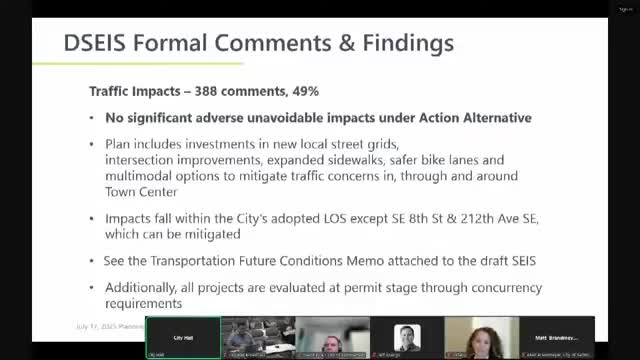Sammamish Council Reviews Housing Density and Traffic Impact in Local Development Plans
July 20, 2025 | Sammamish City, King County, Washington
This article was created by AI summarizing key points discussed. AI makes mistakes, so for full details and context, please refer to the video of the full meeting. Please report any errors so we can fix them. Report an error »

The Sammamish City Planning Commission convened on July 17, 2025, to discuss critical developments and community concerns regarding local infrastructure, housing density, school capacity, and environmental impacts. The meeting highlighted the findings from the draft Supplemental Environmental Impact Statement (SEIS) and addressed public feedback on various issues.
The discussion began with an overview of community concerns, particularly regarding traffic, which accounted for nearly half of the public comments. The SEIS indicated no significant adverse impacts from the proposed developments, although one intersection at Southeast Eighth and 212 was identified as potentially failing under both action and no-action alternatives. Mitigation strategies, including the possibility of a roundabout or traffic signal, were proposed to address this issue.
Key infrastructure improvements were also outlined, with plans for investments in local street grids, intersection enhancements, and expanded sidewalks and bike lanes, primarily funded by developers. The commission emphasized that all projects would undergo a concurrency evaluation during the permit stage to ensure that any traffic issues are resolved before development proceeds.
Housing density emerged as another focal point, with 41% of respondents expressing concerns about the number of housing units. The SEIS compared densities under different alternatives, revealing that the action alternative would allow for 25.5 units per acre, significantly higher than the 12.7 units per acre under the no-action alternative. This increase is part of a broader strategy to accommodate growth while managing critical areas effectively.
Concerns regarding school capacity were raised by 28% of respondents. The commission noted collaboration with the Lake Washington School District, which anticipates a 15% decline in enrollment from 2028 to 2035. This forecast suggests that current growth may not lead to overcrowding in local schools, and ongoing communication will ensure that development data aligns with school planning.
Environmental impacts were also a topic of discussion, with 19% of comments addressing this issue. A 2023 hydrology study indicated that stormwater management improvements would enhance drainage in the town center. The commission reaffirmed that critical area regulations protecting 83 acres of land would remain unchanged, and new landscape regulations promoting drought-resistant and native species were proposed.
In conclusion, the meeting underscored the city's commitment to addressing community concerns while planning for future growth. The commission will continue to refine its strategies and collaborate with relevant stakeholders to ensure that development aligns with the needs of Sammamish residents. Further evaluations and updates are expected as the planning process progresses.
The discussion began with an overview of community concerns, particularly regarding traffic, which accounted for nearly half of the public comments. The SEIS indicated no significant adverse impacts from the proposed developments, although one intersection at Southeast Eighth and 212 was identified as potentially failing under both action and no-action alternatives. Mitigation strategies, including the possibility of a roundabout or traffic signal, were proposed to address this issue.
Key infrastructure improvements were also outlined, with plans for investments in local street grids, intersection enhancements, and expanded sidewalks and bike lanes, primarily funded by developers. The commission emphasized that all projects would undergo a concurrency evaluation during the permit stage to ensure that any traffic issues are resolved before development proceeds.
Housing density emerged as another focal point, with 41% of respondents expressing concerns about the number of housing units. The SEIS compared densities under different alternatives, revealing that the action alternative would allow for 25.5 units per acre, significantly higher than the 12.7 units per acre under the no-action alternative. This increase is part of a broader strategy to accommodate growth while managing critical areas effectively.
Concerns regarding school capacity were raised by 28% of respondents. The commission noted collaboration with the Lake Washington School District, which anticipates a 15% decline in enrollment from 2028 to 2035. This forecast suggests that current growth may not lead to overcrowding in local schools, and ongoing communication will ensure that development data aligns with school planning.
Environmental impacts were also a topic of discussion, with 19% of comments addressing this issue. A 2023 hydrology study indicated that stormwater management improvements would enhance drainage in the town center. The commission reaffirmed that critical area regulations protecting 83 acres of land would remain unchanged, and new landscape regulations promoting drought-resistant and native species were proposed.
In conclusion, the meeting underscored the city's commitment to addressing community concerns while planning for future growth. The commission will continue to refine its strategies and collaborate with relevant stakeholders to ensure that development aligns with the needs of Sammamish residents. Further evaluations and updates are expected as the planning process progresses.
View full meeting
This article is based on a recent meeting—watch the full video and explore the complete transcript for deeper insights into the discussion.
View full meeting
